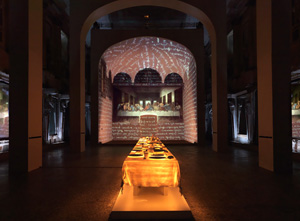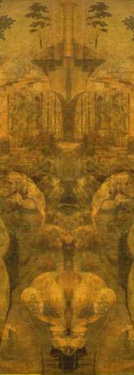Simulations
John Haberin New York City
Peter Greenaway: Leonardo's Last Supper
Even in a digital age, people look at art. They line up to buy timed tickets, and then they line up again to get in. They jostle one another to see it. They want to see it and to be a part of it. They want to be there, with the real thing.
So what if the art is an artifice, an appropriation, a copy, or an illusion? So what if museum crowds spend the most time with the wall labels or with the handful of work that comes with audio commentary? So what if fans and friends at openings spend as much time with each other? Either way, they feel a need to understand and to connect. Either way, they feel a hungering for the real. People being what they are, that can get hard to separate from a hungering from the sacred, and it is not necessarily a good thing for art. 
Peter Greenaway is hungering for the da Vinci code. Leonardo's Last Supper: A Vision all but hits one over the head with his obsessions for nearly an hour. Somewhere between film, spectacle, digital copy, and installation, it is also repetitive, boring, pompous, and silly. It fills the Park Avenue Armory with a full-scale simulation of the painting and of Sta. Maria delle Grazie in Milan, where The Last Supper resides. It also multiplies, repeats, and distorts the simulations in an effort to recapture the original. Then, just when it seems to end, surprise! It throws in an equally hyperactive simulation of another Renaissance painting, by Veronese and now in the Louvre.
Obviously the director is hungering for more. He hopes in time to explore ten famous paintings, which in part explains the installation's odd structure. As one might guess, he aims strictly for high-art crowd pleasers, such as Guernica and Michelangelo's Last Judgment. Where he cannot film the original on location, as in fact with The Last Supper, he simply has a copy made—and boasts of its perfection. He has to simulate the original, because nothing other than the original will do. As Greenaway's title suggests, vision alone just will not do, when one can have a vision.
Supercookies and simulacra
Greenaway is not alone in wondering what will do. It came home to me with "Abstract Expressionist New York." At most blockbusters, museums do not allow photography, but the Museum of Modern Art was inviting a fresh look at its permanent collection. In those rooms, people can take pictures, and they can hardly stop themselves. Everyone, it seems, has to pose in front of a Jackson Pollock. I am used to a struggle to see art, but more often over someone's back.
Thanks to cell phones and social networking, many more people have digital cameras and reasons to use them. Tourists always took snapshots to remind themselves of where they went and what they saw. Now they seem never to have left home unless they have a picture as evidence, preferably hugging one another. Clement Greenberg wanted an art that could not survive reproduction, to rescue the avant-garde from kitsch. Now the near monochrome of Ad Reinhardt or Barnett Newman recalls the studio backdrop for portrait photography.
I can imagine Jean Baudrillard gloating. He wrote thirty years ago about the "hyperreal." Long before Jerry Saltz, the critic, played himself on television, Baudrillard took an early model for reality TV, the Loudon family, as the norm. One can read his philosophy as an alarm or a celebration—scathing, triumphal, or just plain cynical. I am not sure even he knew. The ambiguity fits with his thesis, about the erasure of "the very principle of reality."
 But is his thesis true? The thesis goes beyond a deconstruction of the "originality of the avant-garde" or "work of art in an age of mechanical reproduction." It does not allow art that kind of freedom or distance, but it does hold out a promise of freedom to everyone else. Baudrillard writes that the dispersal of images removes the power of any central, all-seeing eye—what Michel Foucault called the panopticon. Bloggers often make much the same claims for a digital democracy, but then others see the Web as the space of supercookies, cyberbullies, and Google Street View. Museums control photography anyway, in order to profit from selling books.
But is his thesis true? The thesis goes beyond a deconstruction of the "originality of the avant-garde" or "work of art in an age of mechanical reproduction." It does not allow art that kind of freedom or distance, but it does hold out a promise of freedom to everyone else. Baudrillard writes that the dispersal of images removes the power of any central, all-seeing eye—what Michel Foucault called the panopticon. Bloggers often make much the same claims for a digital democracy, but then others see the Web as the space of supercookies, cyberbullies, and Google Street View. Museums control photography anyway, in order to profit from selling books.
Authority aside, one can argue whether the Internet fulfills Baudrillard's prophecy or trashes it. If he is right, there may be no way to know. One way or another, though, people want to distinguish the real and the simulation, especially when the simulation tells them that they cannot. They bought into late Warhol and Interview for a peek at celebrities. The winning artist in Saltz's cable TV show promptly received a real exhibition at the Brooklyn Museum, and real critics promptly panned it. And then there is Peter Greenaway.
Greenaway's films have combined two aspects of the spectacle, as mildly transgressive and ever so stylish. They typically involve a certain sexual naughtiness, a camera within the movie, and Hollywood comforts. Leonardo's Last Supper breaks the Armory into multiple scenes with conflicting points of view. Its pairing of Leonardo da Vinci with Paolo Veronese would have pleased Baudrillard, who saw the Twin Towers of the World Trade Center as simulacra. Yet it also runs with a set duration, as in a movie theater, and it takes its audience between two distinct spaces, as in a forced march. Most of all, it hungers for felt experience—and it turns eagerly to digital manipulation to achieve one.
A hunger for authenticity
The hunger for authenticity, for a pompous confusion of art and religion, begins with the work's title, which duly assigns authorship to Leonardo. After buying timed tickets and an additional ten-minute holding pattern before the hour, the line of ticket holders dissolves into a crowd just outside the old drill hall. One could be waiting outside the refectory in Milan during tourist season. When the imposing wood-paneled doors open, the video experience begins even before the first of its three parts. Images play on all four sides, with one side broken into three screens, plus on two narrow hangings almost like ancient tapestries. A male dancer leaps, as if over the lagoons of Venice, and white birds fly, as if into eternity.
All this evokes tourism quite. So does the first part, which comes painfully close to a promotional travelogue for Italy, as indeed it was (for the 2010 World Expo in Shanghai). It sets the scene through views of Italian cities, from ancient ruins to modern gardens, in order to stress the importance to the Renaissance of public squares and civic spaces. It hustles more or less chronologically through art history, in paintings from roughly 1300 through the High Renaissance. Both the cityscapes and the paintings hit the obvious highlights—the Duomo in Florence, the Sistine ceiling, the ideal city of Piero della Francesca, and Raphael. The dancer blends into Leonardo's Vitruvian man.
The second part opens in the second half of the drill hall, with an intact image of the refectory on the far wall facing close-ups of Jesus—who has just told the apostles that one of them will betray him. At the center stands a sculptural imagining of the supper table in white, like Judy Chicago's Dinner Party for dead white males from 1498. Video lingers over the three fictive windows behind Jesus, light from the refectory's actual window, the play of hands across the table, and peeling paint. Instead of true fresco, Leonardo worked in a mixture of oil and tempera on the wall, like a painstaking house painter, with predictably bad results. The third part returns viewers to the first space, for a documentary about Veronese's Wedding at Cana, right down to an omniscient narrator with a proper BBC accent. Then voices break in, as if at the actual wedding, begging for and questioning the turning water into wine.
Yet each part subverts the illusion, sometimes even intentionally. The video begins and ends with a kind of digital signature—first with flowing white curves that capture the dancer's motion, later with three-digit numbers for each of wedding's more than one hundred guests. In the first part, real and painted cities blend together, and so do real and painted light in the refectory. In working from what the curator calls, redundantly enough, a "perfect clone" of The Last Supper, Greenaway is simulating a simulation of an illusion of a myth about a ritual. Veronese's narrator concludes with the 2006 opening in Venice of a replica of the work, painted in Venice in 1553, as (ouch) "truly an event to celebrate." Then the voices spoil his "happily ever after."
Or do they? The dancer in his loincloth and the white birds are routine tokens of elegance and beauty, and classical music plays from later centuries. Yes, this is what the Italian Renaissance meant, if only the Renaissance were around on the Upper East Side today to appreciate it. Leonardo's painted windows that stand for the Trinity seem to let in daylight and then night, as if the Last Supper lasted twenty-four hours—or maybe a lifetime. The camera transforms even peeling paint into a thing of beauty, like abstraction for hipsters. The digital map of The Wedding at Cana focuses all lines on Jesus, for another surfeit of meaning, although in reality most lines point to the sky above—much as Leonardo adopted a perspective that no human spectator in the refectory can ever match.
Greenaway wants the redundancy and the illusion to affirm the real and the sacred. He does not care all that much about Leonardo's surfaces, symbolism, or psychology, and he does not so much as point out Judas. He prefers to believe, say the program notes, that the painting anticipates Beethoven, the Empire State Building (but apparently not Warhol's Empire), and the discovery of Pluto. As the second part ends, the painting fades into celestial light. Even the complainers at the wedding, amid high-toned choral music, insist on the crisis of lived experience faced with a miracle. Maybe later they will pull out their cell phones and pose in front of the painting.
The cooking channel
Actually, some do prefer the Web to Milan. Who needs northern Italian cooking when one can have The Last Supper at home? High-resolution scans, The Times reported a few years ago, now allow anyone to examine the work's surface up close, inch by inch, without the crowds and advance ticketing. Peeling paint takes on a life of its own, to the point that its realism anticipates the fragmentation of vision in Claude Monet, Georges Seurat and his Circus Sideshow, or Paul Signac. Still another Web site claims to detect hidden presences in the painting by digital manipulation. 
The same technology, The Times continues, now lets wealthy collectors and hoarders display copies without missing a thing. Worried about underinsuring all that art on the wall? Get it into secure storage and go for a good display panel instead. Go, in fact, for da Vinci. Or use jpegs to ease shopping for contemporary art. Art is literally coming off the walls—as fast as bloggers can code it and dealers can display it.
No doubt owing to the free publicity, I could not gain access to the site the next day to see for myself, but I could already imagine its power. I could picture the oil colors that Leonardo, alas, applied directly to the refectory wall coming right at me—and I could only wish that Greenaway had tried to imagine them, too. However, that already points to a departure from the experience of the original. Faced with a painting, a good observer may get up close to linger over the medium in three dimensions. It will not, though, so readily dissolve into shards before one's eyes. Its tactile and visual luster will differ, too, from the crisp brilliance of a monitor.
A painting makes it harder to overlook art as object and as image, a challenge at the very heart of Greenaway's installation. One encounters a jpeg or print as two dimensional, with the only illusion of a third dimension due to the artist's skill. That makes the appearance of paint in reproduction all the more jarring, just as faces in torn posters photographed by Walker Evans carry the shock of ripped flesh. In a splendid exploration of art and illusion, Barbara Savedoff attributes the shock to photography's assumed realism. One might better speak of its assumed flatness. Greenaway tries to overcome that flatness in the space of drill hall.
One might speak, too, of the assumptions behind the Sunday Times. Its writer regularly reports on television and business, not art. Here she bolsters the aura of high-end media, both new and old, right in the Christmas shopping season and just when strapped consumers are shying away from HDTV. Paradoxically, she also relies on a reproduction to celebrate art's immediacy and its universal truth. Leonardo can now look ahead to Impressionism or the shopping mall. He really cooks.
Naturally The Last Supper has inspired a Web site or two, and Leonardo appreciated technology as much as anyone in his time. However, one should see beyond the science to the role of money, markets, and familiar longings. Wealthy buyers are turning to new media to purchase tangible goods—along with such preindustrial intangibles as status and culture. Artists and the public can get swept up in markets, too, but they also know enough to rebel. Too often, their rebellion embraces myths of its own. Like too many others, Greenaway hungers for the real thing, but also for something sadly larger than life.

Peter Greenaway's "Leonardo's Last Supper: A Vision" ran at the Park Avenue Armory through January 6, 2011. I quote The New York Times for December 2, 2007, by Virginia Heffernan on high-resolution scans. Related reviews have given attention to Leonardo as pixels, art and science as visions of nature and humanity, science and Postmodernism, the materials and methods of art, and how digital art can lie.




